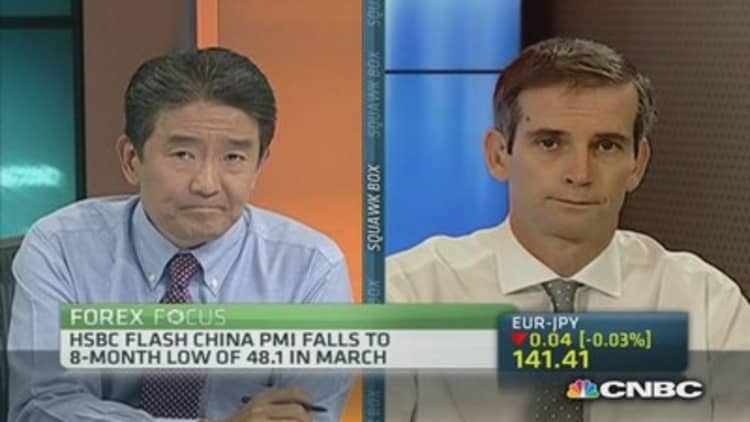
The resilience of the euro and the Australian dollar has stumped analysts, with one saying that currency markets are now living in an alternative world.
The Australian dollar, also known as the Aussie, rose to $0.9158 on Tuesday, its highest level this year. It is closely tied to the health of China's economy and the fact that the rally has come amid signs of weakness in China, Australia's biggest trading partner, has taken analysts by surprise.
(Read more: Aussie dollar resilience: Here today, gone tomorrow?)
Meanwhile, the has also proved resilient in the face of weak manufacturing activity data from China and a dip in European factory activity data on Monday. It gained more than 1 percent against the dollar on Monday and was trading at around $1.3829 on Tuesday.
"We're living in one those alternate worlds at the moment here in foreign exchange land," Robert Rennie, global head of FX strategy at Westpac bank, told CNBC.
Rennie said the Aussie's jump upwards on Monday was "bizarre" in his view given China's bleak manufacturing data, but added that the move may reflect investors starting to view China data and its relation to the Aussie differently.
China's manufacturing activity contracted for a third straight month in March, a Markit/HSBC survey showed on Monday.
"In the world we live in at the moment bad news out of China is actually good for the Aussie because it suggests the possibility of a triple-R cut or indeed further fiscal stimulus increases," he said, referring to a possible cut in the reserve requirement ratio - the amount of cash local banks must keep in reserve.
(Read more: Don't buy therecent Aussie dollar bullishness)
China's slowing economy has stoked chatter that Beijing is moving closer to unleashing monetary and potentially fiscal stimulus measures as soon as next quarter.
Rennie said he was not confident this 'alternate world' was here to stay.
"I'm not sure I'm confident in that story ... given weaker commodity prices...it's difficult to get too upbeat on the outlook for Aussie," he said.

The price of copper and iron ore - both of which are major exports out of Australia - have tanked in recent weeks, further confounding analysts as to why the Aussie is staying strong.
Callum Henderson, global head of FX Research at Standard Chartered bank, said there are a number of other factors holding the Aussie up, aside from what's going on in China.
He pointed to the fact that the market was "massively short" the Australian dollar at the moment.
Henderson added that the the Reserve Bank of Australia's transition from a dovish to neutral bias has led to a significant jump in the nominal yield versus real yields in Australian government bonds, boosting the appeal of the Aussie.
(Read more: Is Australia's stockmarket getting lopsided?)
Finally Asian central banks have started to become slightly more positive and reallocated funds into the Aussie, he said.
But Henderson added that he did not expect the Aussie's resilience to continue, as weaker commodity prices and a mixed picture for the domestic economy starts to be priced in. He said the country's central bank could start talking it down again soon as well.
In the past, comments from Governor Glen Stevens, who previously said he would prefer to see the currency at 85 cents, have helped push the currency lower.
Investors will be watching comments from Stevens and deputy governor Philip Lowe, who are both speaking publicly this week, ahead of next week's board meeting.
— By CNBC's Katie Holliday: Follow her on Twitter @hollidaykatie


